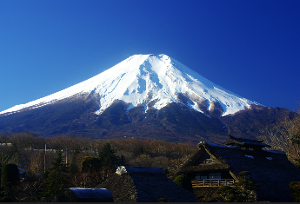
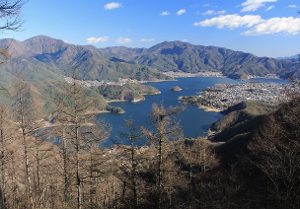
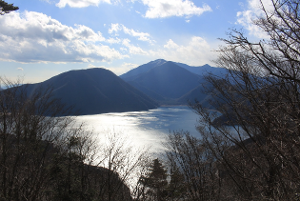
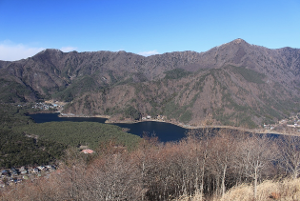
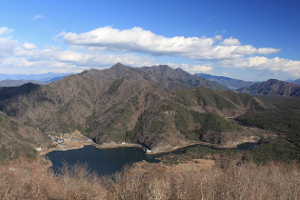
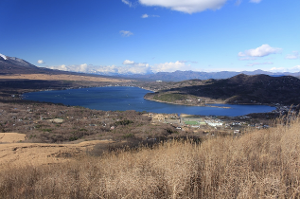
The name Fuji Five Lakes name comes from the fact that there are five lakes formed by previous eruptions of Mount Fuji. From west to east the lakes ("ko" in Japanese) are: Lake Motosu, Lake Shoji, Lake Saiko, Lake Kawaguchi (the main and largest lake), and Lake Yamanaka (the second biggest lake). Another feature of interest is the Aokigahara Jukai Forest, a dense forest growing out of an ancient lava field that flowed northwest from Mt. Fuji. In this area are various caves created by lava tunnels.
Given the time and distance from Tokyo (where most visitors will be coming from), we recommend taking the train from the Tokyo area (Shinjuku Station is the most direct starting point) to either the Otsuki Station or the Kawaguchiko Station. Both stations have several rental car outlets where you can reserve a car in advance.
Mount Fuji (富士山, also called Fuji-san), is located on the main island of Honshū. It is the highest mountain in Japan, standing 3,776.24 m/12,389.2 ft. It is the second-highest volcano located on an island in Asia (after Mount Kerinci on the island of Sumatra), and seventh-highest peak of an island on Earth. Mount Fuji is an active stratovolcano that last erupted from 1707 to 1708. The mountain stands about 100 km/62 mi southwest of Tokyo and can be seen from there on clear days. It's exceptionally symmetrical cone, which is snow-capped for about 5 months of the year, is commonly used as a cultural icon of Japan and it is frequently depicted in many arts and photographs, as well as visited by sightseers and climbers during the climbing season in July and August.
Mount Fuji is one of Japan's "Three Holy Mountains" along with Mount Tate and Mount Haku. It is a Special Place of Scenic Beauty and one of Japan's Historic Sites.[7] It was added to the World Heritage List as a Cultural Site on June 22, 2013.[7] According to UNESCO, Mount Fuji has "inspired artists and poets and been the object of pilgrimage for centuries". UNESCO recognizes 25 sites of cultural interest within the Mount Fuji locality. These 25 locations include the mountain and the Shinto shrine, Fujisan Hongū Sengen Taisha, as well as the Buddhist Taisekiji Head Temple founded in 1290, later depicted by Japanese ukiyo-e artist Katsushika Hokusai. Courtesy of Wikipedia
ACCOMMODATIONS: There is a large variety of adequate and more than adequate accommodation options in the Fuji Five Lakes area of Yamanashi Prefecture where you can spend 1-3 nights. One of the most unique options is to spend 1-2 nights at the upscale but unique Hoshinoya Fuji (MapCode: 59 089 594*36). Another high-end ryokan is the Kozantei Ubuya (MapCode: 161 332 139*00). If you have the time you could spend a night at a lodging at each of the 5 lakes.
You can also easily reverse this itinerary, if you wish, just by following the MapCodes in the reverse order.






The name Fuji Five Lakes name comes from the fact that there are five lakes formed by previous eruptions of Mount Fuji. From west to east the lakes ("ko" in Japanese) are: Lake Motosu, Lake Shoji, Lake Saiko, Lake Kawaguchi (the main and largest lake), and Lake Yamanaka (the second biggest lake). Another feature of interest is the Aokigahara Jukai Forest, a dense forest growing out of an ancient lava field that flowed northwest from Mt. Fuji. In this area are various caves created by lava tunnels.
Given the time and distance from Tokyo (where most visitors will be coming from), we recommend taking the train from the Tokyo area (Shinjuku Station is the most direct starting point) to either the Otsuki Station or the Kawaguchiko Station. Both stations have several rental car outlets where you can reserve a car in advance.
Mount Fuji (富士山, also called Fuji-san), is located on the main island of Honshū. It is the highest mountain in Japan, standing 3,776.24 m/12,389.2 ft. It is the second-highest volcano located on an island in Asia (after Mount Kerinci on the island of Sumatra), and seventh-highest peak of an island on Earth. Mount Fuji is an active stratovolcano that last erupted from 1707 to 1708. The mountain stands about 100 km/62 mi southwest of Tokyo and can be seen from there on clear days. It's exceptionally symmetrical cone, which is snow-capped for about 5 months of the year, is commonly used as a cultural icon of Japan and it is frequently depicted in many arts and photographs, as well as visited by sightseers and climbers during the climbing season in July and August.
Mount Fuji is one of Japan's "Three Holy Mountains" along with Mount Tate and Mount Haku. It is a Special Place of Scenic Beauty and one of Japan's Historic Sites.[7] It was added to the World Heritage List as a Cultural Site on June 22, 2013.[7] According to UNESCO, Mount Fuji has "inspired artists and poets and been the object of pilgrimage for centuries". UNESCO recognizes 25 sites of cultural interest within the Mount Fuji locality. These 25 locations include the mountain and the Shinto shrine, Fujisan Hongū Sengen Taisha, as well as the Buddhist Taisekiji Head Temple founded in 1290, later depicted by Japanese ukiyo-e artist Katsushika Hokusai. Courtesy of Wikipedia
ACCOMMODATIONS: There is a large variety of adequate and more than adequate accommodation options in the Fuji Five Lakes area of Yamanashi Prefecture where you can spend 1-3 nights. One of the most unique options is to spend 1-2 nights at the upscale but unique Hoshinoya Fuji (MapCode: 59 089 594*36). Another high-end ryokan is the Kozantei Ubuya (MapCode: 161 332 139*00). If you have the time you could spend a night at a lodging at each of the 5 lakes.
You can also easily reverse this itinerary, if you wish, just by following the MapCodes in the reverse order.
The name Fuji Five Lakes name comes from the fact that there are five lakes formed by previous eruptions of Mount Fuji. From west to east the lakes ("ko" in Japanese) are: Lake Motosu, Lake Shoji, Lake Saiko, Lake Kawaguchi (the main and largest lake), and Lake Yamanaka (the second biggest lake). Another feature of interest is the Aokigahara Jukai Forest, a dense forest growing out of an ancient lava field that flowed northwest from Mt. Fuji. In this area are various caves created by lava tunnels.
Given the time and distance from Tokyo (where most visitors will be coming from), we recommend taking the train from the Tokyo area (Shinjuku Station is the most direct starting point) to either the Otsuki Station or the Kawaguchiko Station. Both stations have several rental car outlets where you can reserve a car in advance.
Mount Fuji (富士山, also called Fuji-san), is located on the main island of Honshū. It is the highest mountain in Japan, standing 3,776.24 m/12,389.2 ft. It is the second-highest volcano located on an island in Asia (after Mount Kerinci on the island of Sumatra), and seventh-highest peak of an island on Earth. Mount Fuji is an active stratovolcano that last erupted from 1707 to 1708. The mountain stands about 100 km/62 mi southwest of Tokyo and can be seen from there on clear days. It's exceptionally symmetrical cone, which is snow-capped for about 5 months of the year, is commonly used as a cultural icon of Japan and it is frequently depicted in many arts and photographs, as well as visited by sightseers and climbers during the climbing season in July and August.
Mount Fuji is one of Japan's "Three Holy Mountains" along with Mount Tate and Mount Haku. It is a Special Place of Scenic Beauty and one of Japan's Historic Sites.[7] It was added to the World Heritage List as a Cultural Site on June 22, 2013.[7] According to UNESCO, Mount Fuji has "inspired artists and poets and been the object of pilgrimage for centuries". UNESCO recognizes 25 sites of cultural interest within the Mount Fuji locality. These 25 locations include the mountain and the Shinto shrine, Fujisan Hongū Sengen Taisha, as well as the Buddhist Taisekiji Head Temple founded in 1290, later depicted by Japanese ukiyo-e artist Katsushika Hokusai. Courtesy of Wikipedia
ACCOMMODATIONS: There is a large variety of adequate and more than adequate accommodation options in the Fuji Five Lakes area of Yamanashi Prefecture where you can spend 1-3 nights. One of the most unique options is to spend 1-2 nights at the upscale but unique Hoshinoya Fuji (MapCode: 59 089 594*36). Another high-end ryokan is the Kozantei Ubuya (MapCode: 161 332 139*00). If you have the time you could spend a night at a lodging at each of the 5 lakes.
You can also easily reverse this itinerary, if you wish, just by following the MapCodes in the reverse order.
